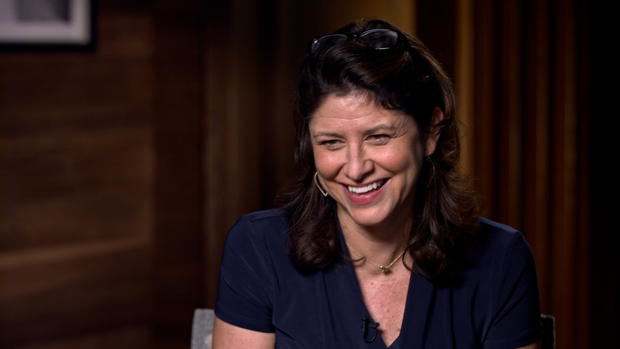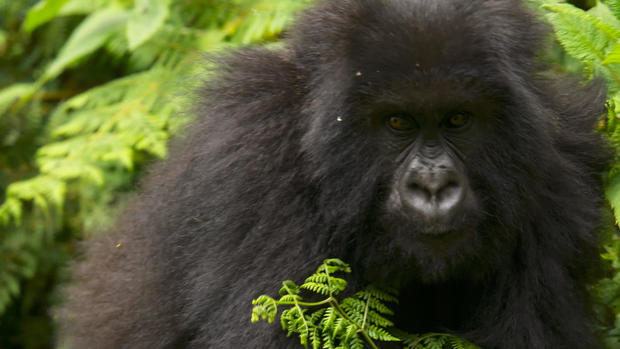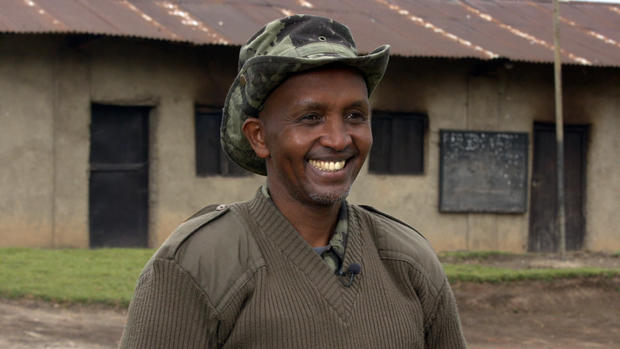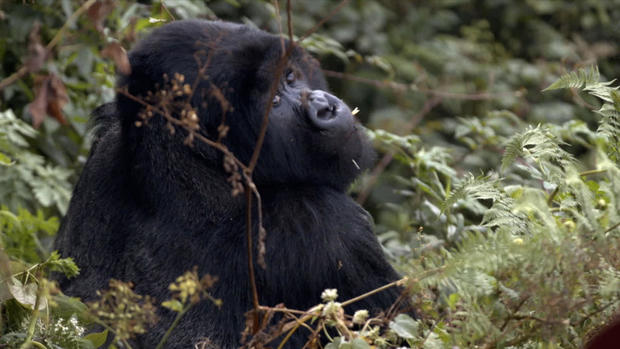Mountain gorillas of Rwanda making a comeback
With close to a million species now threatened with extinction, it's not often you hear about a conservation success story. But as we first reported in November, the mountain gorillas of the East African nation of Rwanda are just that.
When American naturalist Dian Fossey moved to Rwanda half a century ago to study mountain gorillas, their numbers were dwindling, down to just 254 individuals, but today they're up to over 600, with another 400 in neighboring Uganda -- the only great ape whose numbers are actually on the rise. How they've done it? A joint effort by scientists and government to save gorillas and help the human communities around them, with a key role played by tourists.
These are the Virunga Volcanoes, home to most of the world's mountain gorillas. Dian Fossey aptly called them gorillas in the mist. But when the mist lifts, they are gorillas in the sun, doing what mountain gorillas do: eat, rest, eat some more and snuggle.
Tara Stoinski: When you look in the eyes of a gorilla, you see a kindred spirit looking back at you. They are so much like us. They have friends, they have enemies. They love to play. They love to eat. They love to nap. They are incredible moms and incredible dads.
Primatologist Tara Stoinski heads the Dian Fossey Gorilla Fund, a nonprofit research and conservation organization that grew out of Fossey's work.
Lesley Stahl: How many years did she live up here alone?
Tara Stoinski: She was in the forest for 18 years.
Fossey was sent to Rwanda in 1967 by famed anthropologist Louis Leakey, who had also sent Jane Goodall to Tanzania to study chimps.
Tara Stoinski: The people in the region, they gave her a nickname: Nyiramacibiri, which meant Woman That Lives Alone In The Forest. I'm sure they wondered, like, what was she doing up there?
Lesley Stahl: Strange woman living up--
Tara Stoinski: Strange woman.
Lesley Stahl: --in the mount--
Tara Stoinski: And very tall. She was 6 [feet tall].
What she was doing, as Stoinski showed us, was observing gorillas for hours a day.
Tara Stoinski: What she would do each night is come back and type up all of her notes.
Lesley Stahl (Reading): "There is some soft pig grunting heard from the silverback, and gas is released."
Lesley Stahl: And this just goes on and--
Tara Stoinski: On and on, yeah.
Lesley Stahl: --on and on?
Fossey's research -- and her appearances in National Geographic -- helped change the perception of gorillas from aggressive, King Kong brutes, to the gentle vegetarian giants they actually are. But gorillas back then were under assault.
Lesley Stahl: Why were there poachers? Why were people interested?
Tara Stoinski: Well, at the time, people unfortunately wanted parts of gorillas as trophies. So they wanted a gorilla head for their mantelpiece, or a-- a gorilla hand.
The gorillas' habitat was also being eaten away, as thousands of acres of forest were cut down so farmers could plant cash crops up the mountainside. The demarcation line between farmland and forest stands out like a bad haircut, showing how little land gorillas have left.
Lesley Stahl: We cut down their homes.
Tara Stoinski: Yeah, I mean unfortunately, that's the story for wildlife around the world.
But here, that story is getting a rewrite -- and the new version starts at Volcanoes National Park headquarters every morning, where tourists gather to trek to see gorillas, led by expert guides.
The Rwandan government regulates the visits -- no more than eight people per group, for just one hour with the gorillas, with precautions taken to protect them from human illness. The price tag is steep -- $1,500 per person -- turning Rwanda, a country known for its horrific 1994 genocide, not so much for its beautiful scenery, into a prime destination for the wealthy. Some of the most luxurious hotels in the world have opened here, generating tens of millions in tourism revenue.
Lesley Stahl: Other countries have diamonds, oil.
Would you say that gorillas are the most important natural resource of this whole country?
Tara Stoinski: Definitely. Definitely--
Lesley Stahl: Definitely?
Tara Stoinski: Yeah. It's one of if not the top source of foreign revenue, is tourism to see the gorillas.
Lesley Stahl: For the whole country?
Tara Stoinski: For the whole country.
The government gives 10% of the money from those gorilla treks to districts that border national parks, in a program called tourism revenue sharing.
Prosper Uwingeli: As you see this school behind, that was before.
Chief park warden Prosper Uwingeli met us at a local primary school. Behind him was the old school. Behind me, new classrooms paid for by tourism revenue sharing funds.
Lesley Stahl: It costs $1,500.
Prosper Uwingeli: Yes.
Lesley Stahl: --to go see the gorillas for one hour--
Prosper Uwingeli: For one hour. Special experience.
He admits it's a lot, but says it's made a tremendous difference in his meetings with local leaders.
Prosper Uwingeli: We go there and we listen what communities want the tourism revenue sharing to-- to support.
Lesley Stahl: They decide?
Prosper Uwingeli: Yeah, they decide.
This village built a health center, new housing with water tanks and electricity, a new marketplace. The 10% gives communities up to 650,000 U.S. dollars a year.
Uwingeli divides his time between greeting tourists, managing his rangers, and traveling around these villages -- talking, cajoling, and celebrating what tourism revenue has achieved. A few years back, this community chose to get milking cows, which have since had calves. So the cows are now being given to new needy families. And those colorful striped sweaters? They're a product of tourism revenue sharing too. One year this community used its funds to buy knitting machines.
Lesley Stahl: A lot of the guides, porters come from these communities--
Tara Stoinski: --from these communities. And some of them are former poachers themselves.
Lesley Stahl: No?
Tara Stoinski: Yeah.
Lesley Stahl: Some of the porters and guides?
Tara Stoinski: Yeah.
Lesley Stahl: Were poachers?
Tara Stoinski: Or come from poacher families.
Lesley Stahl: So has all poaching of gorillas stopped?
Prosper Uwingeli: Yeah. In Rwanda, yes. Confidently, yes.
But gorillas can still get caught in snares set for smaller animals like antelopes, so the Fossey Fund dispatches a small army of trackers every morning, 365 days a year.
Tara Stoinski: We go out into the forest. We know every gorilla in all of the families that we monitor. We check and make sure every one of them is okay. If one looks ill, we'll notify the veterinarians. And we call this extreme conservation.
It could also be called an extreme workout. We set off on a gorilla trek with Stoinski, Uwingeli and a team of porters. Visiting mountain gorillas is no walk in the park. It's an uphill hike for more than an hour at an altitude of 8000 feet, through that farmland that once belonged to the gorillas just to get to the park.
Lesley Stahl: Are you out of breath?
Tara Stoinski: Yes. [LAUGHS]
Lesley Stahl: Or is it just me?
Then, just as we reached the park border...
Lesley Stahl: [GASP, POINTS] Oh, my goodness gracious, I can't believe this.
A silverback, used to seeing tourists, sat calmly eating.
Lesley Stahl: He's right here.
Unfazed by our gawking and pointing. Uwingeli told us he's an adult male named Lisanga. Fossey Fund country director Felix Ndagijimana taught us how to signal that we come in peace.
Inside the park, after more climbing...
Tara Stoinski: Look, Lesley, look. Lesley--
Lesley Stahl: Oh look at the baby. Oh my goodness.
We found the rest of Lisanga's group. Uwingeli told us the dominant silverback was heading higher up the mountain, so the whole group was following. And so were we.
In a sign of the population's health, this group has 5 infants, and several juveniles.
Lesley Stahl: Oh, my goodness, they're--
Tara Stoinski: Yeah, they're having a ball.
Lesley Stahl: That's serious.
Tara Stoinski: They're havin' a ball.
She told us they play for fun -- and to practice fighting. Or perhaps, just to show us who's boss.
Near us in the forest, it sounded like a silverback photo shoot was going on. But Fossey Fund research assistant Nadia Niyonizeye wasn't snapping ordinary pictures. She was using a technique called photogrammetry to get better measurements of gorilla size by beaming lasers on to the gorilla's body and head, which it doesn't feel.
Nadia Niyonizeye: There are four centimeter in between each.
Lesley Stahl: Oh, I see it.
Back at the office, she uses the dots to make precise calculations of their size.
Science remains the heart of the Fossey Fund's mission. They have the largest collection anywhere of gorilla skeletons, where scientists from around the world come to do research, and a gorilla poop lab.
Lesley Stahl: You gather their poop?
Tara Stoinski: It's like a treasure trove of information for us.
To study stress hormones and do DNA and paternity testing. But Stoinski says they're running out of space.
So they're constructing a new, multi-building green campus with initial funding from Ellen Degeneres [It's being built by MASS Design Group, which 60 Minutes profiled earlier this season.] The campus will celebrate the progress made in saving mountain gorillas -- with plenty of space for researchers, exhibits for tourists and people from local communities. And views of the volcanoes.
Lesley Stahl: And you can see the mist.
Tara Stoinski: It really rolls in.
The building process itself reinforces the fund's motto -- "helping people saving gorillas." It's employing more than 1,500 local workers, more than 20% of them women. One exhibit on display here will teach visitors to speak like a gorilla.
Tara Stoinski: We can play it.
FEMALE VOICE (ON TAPE): Welcome to Gorilla Chat.
Tara Stoinski: You can hear.
FEMALE VOICE (ON TAPE): We're happy that you want to learn to speak like a gorilla.
It plays gorilla vocalizations somewhat comparable to human ones. Yes, gorillas laugh.
Tara Stoinski: Isn't that great? So the idea is that you have to try and mimic it.
Lesley Stahl: That's impossible.
She gave me one she said was simple.
Tara Stoinski: So this is the pig grunt.
Lesley Stahl: What does it mean?
Tara Stoinski: It's kind of like a mild warning. The sort of human version is, "Unh-unh-unh."
Lesley Stahl: You're on thin ice.
Tara Stoinski: You wanna try it with me recording and see?
Lesley Stahl: Yeah.
Tara Stoinski: Okay. (BEEPS)
Lesley Stahl: [GRUNTS] (LAUGHTER) "Try again--"
Tara Stoinski: Again. (LAUGH)
Lesley Stahl: I did such a bad job.
Tara Stoinski: It's hard.
Lesley Stahl: So fun.
Tara Stoinski: Won't it be fun, though?
Stoinski wants school kids to come and be inspired to solve the next set of problems -- increasing numbers of gorillas inhabiting a fixed amount of space.
Tara Stoinski: As the population has increased, but the habitat hasn't, it is putting more pressure on the gorillas. And so the government is looking to try and expand the park so that there will be more space so that population can continue to grow.
There are plans to expand the park by 23% and relocate communities to what the government calls model villages like this one, with electricity and brand new schools. Trying to make park expansion another win-win for gorillas and their human neighbors.
Lesley Stahl: It's a success story.
Tara Stoinski: It is a success story, definitely, but we say it's a fragile success because there are so few of them left and there are still so many threats.
But for now, the news is good. Last year, 33 new baby gorillas were born here.
Prosper Uwingeli: Wow, I mean, you can't have enough of telling those stories of gorillas-- when you look at the moms carrying the babies--
Lesley Stahl: Do you know that when you talk about gorillas, your face completely lights up?
Prosper Uwingeli: I know about it. But much of the smile comes from what they're helping us to achieve. That's really the best way we can serve the next generation of kids, gorillas, and-- and-- and people.
Produced by Shari Finkelstein. Associate producer, Braden Cleveland Bergan. Broadcast associate, Wren Woodson. Edited by April Wilson.
Photos of Dian Fossey courtesy of Bob Campbell Papers/George A. Smathers Libraries/Univ. of Florida








